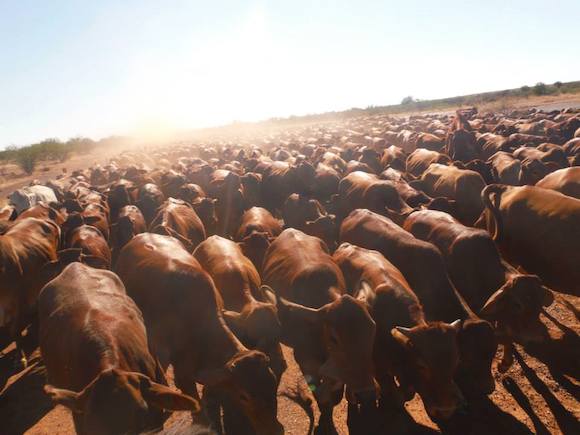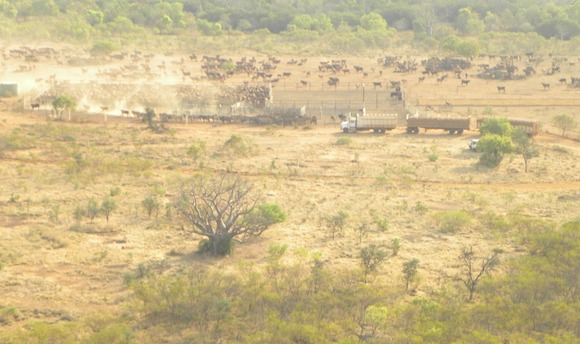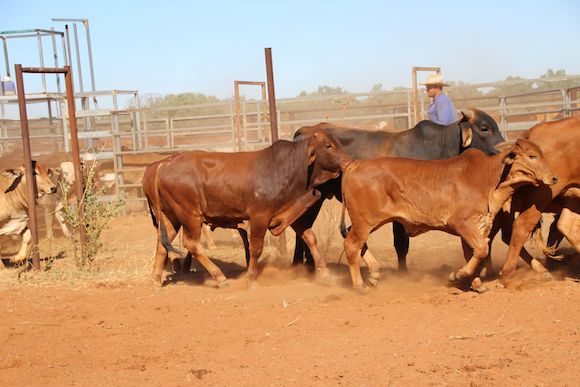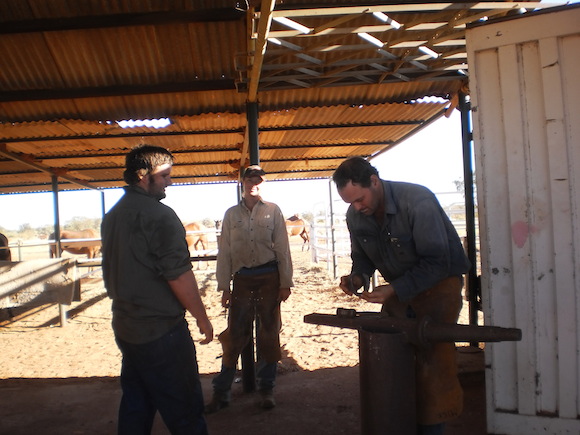Satisfaction and reward
Host: Nerrima Station
Written by Mick Courtney – Manager, Nerrima Station.
Co–operative breeders are the key, I believe, to a smooth mustering, drafting, and processing operation. Time and time again I’m sure we’ve all been held up by un-cooperative animals. Quite often throwing the whole day’s logistics out and plenty of unneeded stress on animals and us.
Some can be quick to blame things such as yard design or the mistreatment on the animals from our predecessors, but in most cases it is a lack of knowledge on our part, or a lack of time allocated for the job that destroys an animals confidence in us.
Where knowledge ends, violence generally begins.
Our ability to work with, and understand, an animal, and what makes an animal stressed and relaxed will determine the efficiency of our mustering, drafting, and processing operation. I believe this is where major financial losses can and do occur. In saying this it is a hard thing to measure and probably not something we have ever been inspired to measure, for obvious reasons. It would shock us all.
Being a traditionalist, I still choose to Coach muster. Mainly for reasons of keeping close contact with our cattle, keeping calves mothered, generally getting cleaner musters, and ease of educating weaners when the time comes. These things are high on my agenda.
A brief description of coach mustering:
After blocking up a smaller mob of cattle early morning (coacher mob) at a reasonably central water point, we’ll set about softening these fresh cattle by walking short distances and blocking up as many times as it takes to get them in hand.
Whilst this is going on choppers are running the rest of the cattle in that general area to us. Once we’ve received all cattle in that area we’ll start the walk home via a few other major watering points in which choppers will have cattle already standing for us to receive them on way past. We are always receiving cattle from choppers in between waters in tens or twenties at a time.
After starting the day with a coacher mob of as little as 40 or 50 head, the mob gradually snowballs through the day until we have our 1500 or 2000 head all in one mob just prior to hitting the yard. By handling smaller mobs of cattle through the day most animals are getting closer contact with our horsemen albeit for a short time. But the advantage of those fresh, livelier, or feral animals entering a quiet, well-handled coacher mob makes the day run pretty smoothly in most cases.
The mob is only as fast as your slowest animals. Our calves generally stay mothered as much as possible whilst on the walk home – imperative to make the day run smooth. The extra time we spend blocking up our mob and letting calves mother will save us a lot more time at the back end of the day.
Our calves are our most vulnerable asset and need a lot of attention right through the mustering and branding process. Calves alone at watering points after musters is a pet hate of mine and we only see half of what gets left behind. However, I do realise our pilots are a lot more conscious of this these days and flying techniques have changed a lot, but I still strongly believe our coacher mustering techniques are advantageous.
Weaning and educating weaners is time consuming at the best of times, having weaners walk and block up in a mob of already educated cattle and contact with horsemen is, I think, a great first education, and no doubt helps us with the tailing and educating process.
Horses are used for all mustering operations here along with helicopters. The horse plant consists of approximately 40 horses of all shapes, sizes, colours, and temperaments – ask Jacob Dunn about temperament, Jake currently leads the “spit tin” tally at present. But no blaming the station owned yangs for his recent injury, one of his own apparently well bred steeds seems to have the better of him and his confidence of late, sorry Jake… hehe.
Horsemanship is of high priority here also with a lot of time going into good solid safe horsemanship, with this goes shoeing as much as staff all hate it and will do anything to avoid it. The least we can do is shoe them every eight weeks so they can carry our staff around all day.
Horses fed at every spare opportunity and after any work at all, no matter how small the job whether it’s a trot around the flat or a 10 hour day. Our horses are a tool for us, no different to a tradesman’s ute, they all need to be maintained and cared for on a daily basis whilst in work and even more so this late in the year.
Once in the yard, Low stress stock-handling is at top of our agenda. Whilst understanding there is a few different versions of these techniques, taught by different people, the principles are similar.
In a nutshell, we are asking and giving the animal an opportunity to move through the yard system efficiently and without the traditional sticks, prodders, whips, and verbal abuse that has turned many a beast into a man killer, and either injuries occur or animal welfare issues generally arise.
Consequently the staff, the cattle, and I end up sour on the job.
Basically when an animal gives you what you’re asking for take the damn pressure off it and reward it for doing so.
Year after year we try and convince ourselves we are doing the right thing mustering and yarding and processing our cattle, and sure we are no doubt doing everything possible to make it easier on them.
Although we still muster and make them walk 20 or 30km a day then lock them in a big steel yard for one to three days depending, feed them bugger all, brand their calves, take their weaners off them, and then vaccinate them, and not to mention every damn gate they hit their hips on while going through the yard. This sounds a little extreme I know but it’s accurate, and no wonder a few of our cows get the shits with that after ten years.
Sal and I are proud to stand back and watch proceedings in the yard, our staff all practice these principles and better still, understand the consequences of bad or careless decisions when working with stock. Mainly due to my weekly rants on my soapbox! It’s quite comforting to know that our staff place a lot of importance on animal welfare in our absence. We have an obligation to not only our company, financially and morally, but also to the rest of the industry.
It’s honestly the most inexperienced crew I’ve had in recent years but the attention to detail and efficiency in our stock work has resulted in one of the easiest years in recent times in most cases being ahead of schedule. I’m very proud of their work ethic, and they are a laugh a minute. All of them.
 Coach mustering keeps the animals as calm and stress-free as possible, they are content to walk with a little direction from the horses.
Coach mustering keeps the animals as calm and stress-free as possible, they are content to walk with a little direction from the horses.





